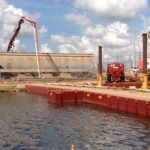- Company: Standard Constructors, Inc.
- Industry: Industrial
- Location: Freeport, Texas
- Expected Completion Date: June 3, 2013
- Project Website
Standard Constructors, Inc. received a contract from FLUOR Corporation to construct a heavy haul bridge for large over sized vessels to gain safe access to the DOW Chemical Oyster Creek facility. The contract involved eighty six, forty foot concrete piles to support the bridge structure, extensive heavy re-bar structure, concrete work over water and a deadline of only forty days until the first delivery arrived from overseas. The project is located over the Velasco Drainage District canal just North of the DOW Chemical Oyster Creek Facility. The bridge spanned approximately one hundred seventy two feet across the canal and had a total surface area including the approaches of more than seven thousand square feet.
What impact does this project have on America?
This bridge helped allow DOW Gulfstream to receive their vessels and achieve their first of many major milestones for two of the world-scale manufacturing facilities in which would later lead to the United States experiencing a manufacturing resurgence along the U.S. Gulf Coast. The VDD Heavy Haul Bridge did not only help aide the construction of the Ethylene Cracker and Propylene Production Units, but with these units created and the advantage of the abundance of Shale Gas, America will be competitive with overseas countries in terms of the cost of raw materials. When this happens, America’s job opportunities will grow.
What interesting obstacles or unusual circumstances did you overcome to complete the project?
The directive associated with the task, though simple to understand, included critical time constraints that added an additional challenge. Keeping a short work schedule in mind, a critical, safe concise and detailed work plan was developed. The critical schedule constraints set the pace for the entire job and was created by the first vessel, which was being shipped from overseas. This manifested numerous of other obstacles to overcome and required working twelve hour days, seven days per week (with every other Sunday off) to successfully complete the project on time. Working off plan, first priority would be the client obtaining the TxDOT permit to build a new driveway off of South Highway 332. This measure was necessary as it would allow opportunity to work on the bridge from the north and south abutments simultaneously. However, TxDOT Bridge Department required a thirty day turnaround in order to issue a permit of that nature. Naturally this created a myriad of obstacles for Standard as time was of the essence and attempting to wait was not an option. This complication led to an alternative plan, which involved building the bridge from the south. The benefits of doing this were a proper work platform could be attained and also added ability to gain access to the north bank of the canal. Another concern rested in the water level elevation of the canal. To install the pile friction collars to their proper elevation, the canal would need to be lowered thirty six inches or a cofferdam to encompass each bent would need to be installed. However, after coordinating with the Velasco Drainage District, it was found the water level could only be lowered twelve inches without affecting the daily work process of the canal. Cofferdams were not a feasible option as the water flow could not be impeded in any way. This meant that each of the twenty, three hundred pound friction collars, whose only job is to support the entire weight of the concrete pile caps would need to be installed under water, adding another level of difficulty to the process. A railroad also blocked access daily to the main entry/exit point for the work site, which meant alternate medical emergency routes needed to be established as well as heavy equipment and concrete pump truck mobilization across the tracks. Beyond initial weather concerns regarding heat, consideration was also needed for the possibility of a hurricane forming in the Gulf of Mexico. One requirement from the Velasco Drainage District was that all obstacles that could impede water flow in the canal would need to be removed from the water way. In order to fulfill this requirement a quick demobilization plan was devised in the event this measure would prove necessary.
What dangers and risks did you encounter, and describe any extraordinary methods used to keep workers safe?
Though consistently considering and understanding the severity of the schedule and challenges faced by limited access to the canal, the safety and comfort of the crews assigned to this task was the most important. A major part of the plan involved swinging twelve hour shifts in the Texas scorching heat. As a result of this, a Heat Stress Awareness plan was implemented and geared towards helping crews involved to overcome the grueling temperatures and long hours with as little discomfort as possible. In accordance with this plan, establishing ample shade and work break areas within the real estate available in the area was at the center of the plan. In addition, SCI supplied continuous flow of fresh drinking water, pop up tents, wet fans, and a work/rest ratio that in conjunction with each other kept the employees safe, cool and hydrated during the blistering hot hours of the day, which often included one hundred percent humidity and temperatures above ninety five degrees. These measures proved to be beyond sufficient and allowed us to take care of all crews involved while cumulatively working toward the objective.
How did you leverage new technologies to work faster and reduce waste?
The project featured extensive heavy concrete support structures such as the bridge abutments, bents, wing walls, retaining walls, load spreader surface beams, and DOT approved over sized steel reinforced elastomeric pads installed to withstand over six hundred tons. These pads reduced the amount of time and material used to form a bridge with the conventional pour in place design. The project was complete and ready for the first delivery ahead of schedule with Zero recordable injuries or incidents.








